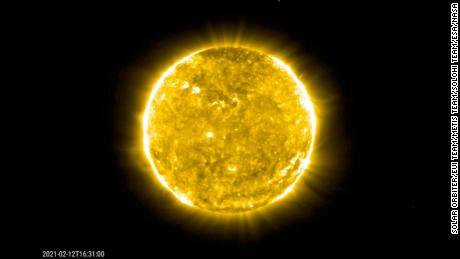(CNN) A happy accident has resulted in the Solar Orbiter mission spying eruptions from the sun. These eruptions, called coronal mass ejections, blast out solar particles across the solar system and have the potential to disrupt technology if they reach Earth.
These eruptions were detected by multiple instruments on the spacecraft during a close flyby of the sun, which is called a perihelion, on February 10. This flyby brought the spacecraft within 46.5 million miles of the sun -- that's half the distance between the massive star and Earth.
This is the first time the orbiter has witnessed such eruptions.
This imagery comes from three different instruments on Solar Orbiter showing eruptions happening on the sun. {"@context": "http://schema.org","@type": "ImageObject","name": "This imagery comes from three different instruments on Solar Orbiter showing eruptions happening on the sun.","description": "This imagery comes from three different instruments on Solar Orbiter showing eruptions happening on the sun.","url": "//cdn.cnn.com/cnnnext/dam/assets/210517162258-01-solar-orbiter-coronal-mass-ejection-screengrab-large-169.jpg"}

The mission, which launched in February 2020, is a collaboration between NASA and the European Space Agency. Although Solar Orbiter's main scientific agenda doesn't begin until November -- to study the sun's north and south poles -- it has already made close passes by the sun that captured the closest images ever taken of our star and revealed " campfires " near its surface.
Currently the spacecraft is in its cruise phase, which allows for calibration of some of the 10 instruments aboard. During the cruise phase, four of its instruments are up and running and have been since launch. The February flyby presented mission teams with an opportunity to conduct observations and test out some of their instruments.
Solar Orbiter's Metis instrument blocks out the bright light from the sun's surface, so the eruption of particles to be seen in visible light (left) and ultraviolet light. {"@context": "http://schema.org","@type": "ImageObject","name": "Solar Orbiter's Metis instrument blocks out the bright light from the sun's surface, so the eruption of particles to be seen in visible light (left) and ultraviolet light.","description": "Solar Orbiter's Metis instrument blocks out the bright light from the sun's surface, so the eruption of particles to be seen in visible light (left) and ultraviolet light.","url": "//cdn.cnn.com/cnnnext/dam/assets/210517162344-02-solar-orbiter-coronal-mass-ejection-screengrab-large-169.jpg"}
Read More
Once the scientific mission begins in earnest, all 10 instruments will work together to create joint observations of our sun. This flyby was unique in that the spacecraft was actually behind the sun from the perspective of Earth, causing a lag in data transfer rates. This delayed the data's delivery to mission scientists, so some of it is still being analyzed. Solar Orbiter mission shares closest images of the sun, reveals 'campfires' near its surface The mission team wasn't expecting Solar Orbiter to record any data as it passed behind the sun and looped back around in orbit on the other side, so capturing these eruptions was a happy accident. So far, the data tells an interesting tale. During the flyby, three of the spacecraft's instruments all registered a pair of coronal mass ejections. These tools included the Extreme Ultraviolet Imager (EUI), the Heliospheric Imager (SoloHI) and the Metis coronagraph. Meanwhile, other spacecraft like ESA's Proba-2 and the ESA/NASA Solar and Heliospheric Observatory both witnessed these events from the Earth-facing side of the sun. A NASA mission called STEREO-A also spied the event from a different perspective. var id = '//platform.twitter.com/widgets.js'.replace(/\s+/g, '');!!document.getElementById(id) || (function makeEmbedScript(d, id) {var js,fjs;js = d.createElement('script');js.id = id;js.charset = 'utf-8';js.setAttribute('async', '');js.src = '//platform.twitter.com/widgets.js';fjs = d.getElementsByTagName('script')[0];fjs.parentNode.insertBefore(js, fjs);}(document, id)); Speaking of #CMEs , the first @ESASolarOrbiter movies showing #CMEs , or coronal mass ejections, including during the spacecraft's February perihelion pass, released today
